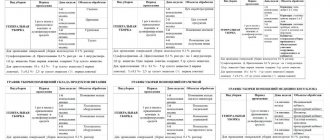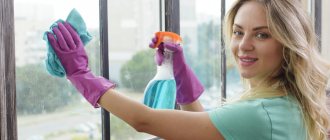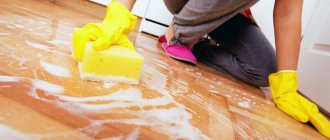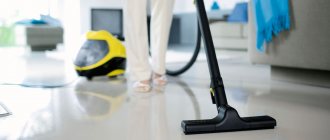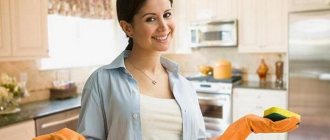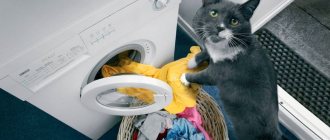There are many facilities where general cleaning is regulated by law. If in an office, at an industrial facility or a private enterprise, general cleaning of premises can be carried out as needed, then at catering establishments, children's institutions, medical institutions, food and pharmaceutical industries, the requirements for quality and timing are specified in SNiP.
Equipment and cleaning products
Since the purpose of cleaning in health care facilities is not only to remove contaminants, but also to disinfect surfaces, the work will require professional cleaning products and special disinfectant solutions that have antimicrobial and antibacterial effects. In addition, each type of work requires special equipment:
- 2 containers each for surface treatment (for washing floors, walls, equipment, furniture);
- window cleaning containers;
- 2 mops (for walls and floor);
- 2 rags (sterile and non-sterile);
- floor cloth;
- 2 brushes for radiators;
- bactericidal lamp;
- overalls (gloves, apron, robe, mask, cap) and safety shoes.
Reusable items should be labeled to indicate their purpose. As for sterile rags, they will be required for general cleaning of aseptic and sensitive rooms.
When working with disinfectant solutions, you must follow safety rules according to the instructions on the packaging. The preparation of solutions must be carried out in accordance with the standards and recommendations specified in the instructions. On average, the consumption of such products is 100-150 ml per 1 square meter of surfaces.
General cleaning of a hospital department: Algorithm
So, we begin to generalize in the hospital department.
Whether general cleanliness is carried out weekly or once a month, the algorithm is practically the same for all departments.
But each person has their own set of marked equipment, depending on the operating mode and purpose of the department.
Initially, we check whether we have all the necessary tools and antiseptics intended for cleaning.
Do not forget about disconnecting electrical appliances from the network. This also applies to quartz lamps.
We empty the offices of furniture and equipment to the maximum, or move them to the center of the room.
In the wards, the beds are moved away from the walls and covered with special oilcloth fabrics. During this time, patients should not be in the room.
We put on special equipment. We remove and throw away garbage from the premises. Prepare and pour solutions into containers.
We spray doors, windows, window sills, equipment, furniture with an antiseptic from a spray bottle, wiping them with napkins.
Do not forget about lighting lamps, which are recommended to be cleaned with medical alcohol and rags, which should be dry.
The most labor-intensive procedure is the treatment of radiators.
We use brushes to treat both the radiator itself and the space behind it, where dust especially likes to accumulate. Wash the floor with antiseptic agents.
All manipulations are carried out with the doors closed, but it is advisable, if possible, to open the windows during cleaning, if it is not the cold season.
Now you can rest for half an hour and change your clothes to a sterile set. Don't forget to disinfect your shoes with the solution.
Next, tap water comes into play, with which all surfaces treated with antiseptics are washed. Then we wipe them dry.
All that remains is to wash the floors with clean water and turn on the quartz lamps for an hour.
After airing the premises again, within half an hour, we disinfect them with bactericidal irradiators.
As for pillows, mattresses, and upholstered furniture, they are cleaned by knocking them out, after covering them with a damp cloth or a special solution.
True, cleaning companies have more modern methods that allow you to avoid unnecessary labor costs and carry out cleaning at a high level.
All that remains is to process the instruments: disinfect, wash, dry. Sets of equipment are handed over to the laundry for washing and sterile processing.
We record the date and time of the general cleaning procedure in the department in the journal provided for this purpose.
Procedure for general cleaning
Current cleanup
Routine cleaning in health care facilities involves wet cleaning of all surfaces using special products. The frequency of the procedure depends on the purpose of the room. Thus, in postoperative wards, dressing rooms and intensive care wards, routine cleaning should be performed 2 times, in therapeutic wards - 1 time, and in wards for newborns - 3 times a day. Work should be performed in the specified order. The algorithm for carrying out routine cleaning in health care facilities is as follows:
- Wear special clothing and safety shoes.
- Treat surfaces (equipment, walls, furniture, doors, sinks) with a disinfectant solution.
- Rinse surfaces using a container of clean water.
- Wash the floor using the “two buckets” technique.
- Perform quartz treatment of the room.
- Treat equipment and rags with disinfectants, rinse them with clean water and dry.
We recommend: School ventilation schedule according to SanPiN and its sample
To wash the floor using the “two buckets” method, you will need two containers. The first is filled with water with an antiseptic, the second with ordinary tap water. The work begins with washing the floor with a cleaning rag soaked in the first container, then the rag is rinsed in the second container and used to wash the same area of the floor again.
To monitor the operation of bactericidal lamps, it is necessary to keep a logbook. After completion of quartzing, ventilation is carried out. You can close the windows (vents) only when the smell of ozone completely disappears.
Sanitary standards and cleaning rules
According to the requirements of sanitary standards, general cleaning is carried out at least once a month.
According to the SOP for cleaning premises in health care facilities (SP 3.5.1378-03 and SanPiN 2.1.3.2630-10), the schedule for the described activities should be drawn up by the administration of the medical institution, taking into account the relevant profile of the hospital . According to existing standards, general cleaning should be carried out at least once a month in all doctors’ offices, in patient rooms, in treatment rooms, and in corridors. Everything must be disinfected: all horizontal and vertical surfaces, walls, floors, ceilings, lamps and equipment used.
In operating rooms, maternity wards, dressing rooms, where instruments are sterilized, planned complete disinfection is carried out once a week. The administration draws up a schedule for general cleaning of the premises in advance - a sample of its completion is sent down from above by the supervisory authorities. The report on the work done is kept by the senior nurse. The head of the department accepts and checks compliance with actual results. The work done is recorded in a special journal.
Unscheduled measures are carried out immediately after receiving unsatisfactory results of checking the sterility and microbial contamination of the external environment. Relevant entries are made in journals
More than just cleaning
In fact, spring cleaning is not only about a clean house, it is also about a clean head. By freeing your space from dust and unnecessary things, you restore order within yourself, become calmer and more collected. Notice that as soon as you have cleaned up, your mood immediately becomes better, you want to do things more actively and make important decisions. And the cleaner the space around, the more space there is for new ideas within you. Everything should be on the shelves! The attic will help you get rid of unnecessary things and tidy up your home so that it is clean and fresh. Leave your comfort and your things in the Attic.
Quality check: checklist for the owner
Regardless of who carries out the cleaning in the salon - a cleaning service, a cleaner or employees on their own, the employee responsible for the disinfection regime or the owner of the beauty salon must accept the work and check the quality of the work.
Verification aspects:
- cobwebs on ceilings, in corners, behind furniture;
- Are the trash cans emptied?
- cleanliness of surfaces - cabinets, shelves, cabinets;
- cleanliness of the walls;
- dust on office equipment – monitor, phone, printer;
- furniture - chairs, tables, armchairs;
- doors - slopes, handles, glass;
- switches and sockets;
- floors, baseboards;
- radiator grille.
You can download an example checklist in the attached file and print it for future use.
Checklists for monitoring daily and general cleaning
Tip: Change aspects of the inspection periodically to avoid a situation where cleaning is carried out only in the areas inspected.
Waste disinfection
If a beauty salon does not provide medical services, then as a result of its work, class B and C waste is generated, but some of it is still subject to disinfection. This is briefly mentioned in SanPiN in paragraph 9.20.
In addition to disposable waterproof wipes, all consumables that have come into contact with human skin are subject to mandatory disinfection:
- Disposable files, buffs;
- Orange sticks;
- Replaceable files from the basics;
- Wipes used to remove gel polish;
- Cotton swabs and microbrushes used to stop bleeding from cuts;
- Napkins and sheets for manicure and pedicure;
- Gloves and masks for clients;
- Shoe covers.
A separate bin with a closing lid and labeling must be provided for such waste. The labeling indicates “for disinfection of disposable wipes,” as well as the name and concentration of the disinfectant.
How to disinfect waste
- Insert a white or black garbage bag with several holes in the bottom into the marked bucket. The use of red and yellow bags is prohibited - they are intended for medical waste;
- Fill in the working solution. It must be prepared according to the instructions for the disinfectant using the “waste disinfection” mode. If this is not in the instructions, then using the virus mode;
- Throughout the day, throw all the waste listed above into this bin. Some of them float and need to be submerged. A regular water bottle can help with this. Files and replaceable files floating on the surface are a violation of the disinfection regime, since according to SanPiN, treatment is considered successful only when the item is completely immersed in the solution;
- At the end of the shift, lift the waste bag and wait until the disinfectant solution flows through the holes in the bag;
- Place the waste in another, whole bag, tie it up and dispose of it along with household waste.
Every day a new solution is prepared to disinfect waste.
What does not need to be disinfected:
- Packaging of materials, products;
- Your own disposable gloves and masks;
- Other waste that was used during the workday but did not come into contact with the client's skin.
Such garbage is thrown into a separate bin and disposed of as solid waste without pre-treatment.
Helpful tips for quick cleaning
In addition to using suitable products and zoning the area, you must also strive to organize cleaning as quickly as possible. After all, the time that can be spent on this with the wrong approach can be directed in a different direction.
Regular cleaning will help keep your apartment or house clean.
Before you begin, you can use the following rules for cleaning your apartment:
- putting things back in their places every day is useful, with this method there will be no need to put everything in its place later;
- Clean weekly, if not all, then at least one area of your home (kitchen, bedroom, living room, bathroom), with this approach there will be no special need for general cleaning;
- Do a spring cleaning every few months, rethink and improve your space, sort things and get rid of unnecessary things.
A clean house is a rule of good manners for its owners.
Whatever cleaning method you choose, be sure to take into account the time and day, and prepare in advance all the necessary useful products. Stock up on a good mood and start cleaning, in this case you will be as pleased as possible with the result, and your home will glow with cleanliness, the warm comfort will add joy.
Carrying out general cleaning work is necessary at least twice a year to ensure the normal sanitary condition of all corners of the home.

